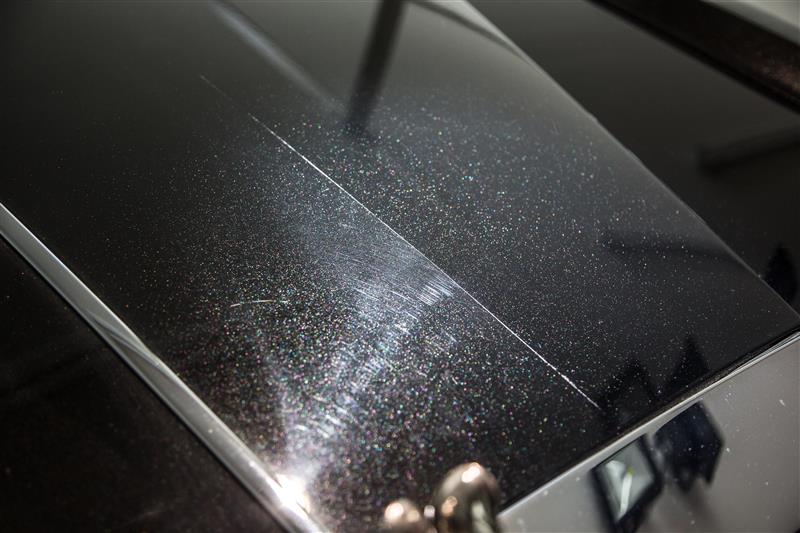Clear vision ahead with our holiday markdowns on Invisible Glass Ceramic Silicone Wiper Blades. Prices as marked.
Few things dull the look of a freshly washed car faster than swirl marks. Under bright light, those fine, circular scratches scatter reflections and break up what should be a smooth, mirror-like shine. Swirl marks form when small particles such as dust, dirt, or debris are dragged across the surface during washing or drying. Over time, these micro-scratches build up in the clear coat and create that hazy, spiderweb effect.
Most swirl marks sit only in the clear coat, not deep in the paint. With the right tools and a little time, you can safely polish them away and bring back a glossy, even finish. The guide below explains each step in the removal process, highlights trusted Stoner Car Care products that make the job easier, and covers how to keep your paint protected long after the polish is done.
What Causes Swirl Marks in Clear Coat
Swirl marks look like random scratches, but they almost always trace back to one source: friction from dirt or debris that moves across the surface. When small particles get caught between your wash mitt, towel, or sponge and the paint, they act like fine sandpaper. Each pass leaves a tiny cut in the clear coat.
Over time, everyday habits multiply the damage:
|
Common Cause |
How It Damages the Clear Coat |
|
Dirty wash tools |
⚠️ Trapped grit acts like sandpaper and cuts into the surface. |
|
Automatic car washes |
⚠️ Brushes collect debris from other vehicles and scratch your paint. |
|
Improper drying |
⚠️ Wiping dust or minerals across the paint leaves fine scratches. |
|
Harsh towels or applicators |
⚠️ Rough or low-quality fibers create micro-scratches, even when clean. |
The circular pattern of swirl marks often comes from the motion used during washing or polishing. Under sunlight or intense garage lighting, these tiny scratches catch and scatter light, producing the familiar swirl pattern that dulls an otherwise glossy surface.
Swirl marks can’t be avoided forever, but you can correct them. The process starts with careful preparation to make sure you’re polishing clean paint, not grinding in more scratches.
Step 1: Wash and Decontaminate the Surface
Understanding what causes swirl marks is only half the solution. The next step is preparing the surface so that polishing can actually fix the damage instead of adding to it.
Before polishing, the paint must be completely clean. Any leftover dirt, dust, or road grime will act like sandpaper and make the problem worse. Use a high-lubricity, pH-balanced car shampoo that’s safe for waxed surfaces. Stoner Car Care MOAB Car Wash is a strong choice because it lifts grime without stripping existing protection.
Wash your car using the two-bucket method: one bucket for soapy water and another for rinsing your mitt. Always work from top to bottom. After washing, inspect the paint by running your hand over the surface with a plastic bag over it. If it feels rough or gritty, bonded contaminants such as tar, overspray, or industrial fallout are still present.
Use a clay bar or clay mitt with a dedicated clay lubricant or quick detail spray to remove these particles. Move the clay gently in straight lines without applying heavy pressure. When the surface feels smooth and glassy, rinse the car again and dry it thoroughly with clean microfiber towels. For faster, safer drying, a single Gauntlet XL Premium Drying Towel can handle most vehicles on its own. Its thick, high-GSM weave absorbs more water with fewer passes, reducing the risk of light scratches while you finish the wash.
Step 2: Assess the Paint and Choose Your Approach
With the surface clean and smooth, it’s time to see what you’re working with. Inspect the paint under direct light. Sunlight works, but a handheld LED inspection light will reveal even faint swirl marks. Look closely to gauge how deep and widespread they are.
If the swirls are light and cosmetic, a mild hand polish may be enough to restore clarity. For moderate or heavier defects, a dual-action (DA) polisher delivers faster, more consistent results. DA polishers are beginner-friendly and far safer for your clear coat than rotary machines, which can generate too much heat if held in one place.
Your tool choice determines the right polish and pad combination. Always start mild and increase aggressiveness only as needed. The goal is to remove as little clear coat as possible while restoring a smooth, even reflection.
Step 3: Pick the Right Polish and Pad
Every swirl mark removal job depends on matching the right level of abrasiveness to the condition of the paint. Polishes and compounds contain microscopic abrasives that smooth the clear coat, removing high points and restoring even light reflection.
For light to moderate swirl marks, start with a finishing polish or an all-in-one cleaner polish designed for clear coats. If the damage is more noticeable, make several light passes instead of using an aggressive compound right away. The goal is to correct the surface while preserving as much of the clear coat as possible.
Use foam pads that match the task: firmer pads for cutting and softer pads for finishing. Wipe away residue with a clean microfiber towel after each section. A light mist of Speed Bead Quick Detailer can help lift remaining polish residue and reveal the true finish. Once the surface looks smooth and even, it’s ready for protection.
Step 4: The Polishing Process
If you’re using a DA polisher, start by applying three or four small drops of polish to the pad. Spread the product over a small section of paint, about two feet by two feet. Begin at a low speed to distribute the polish, then increase the speed slightly while applying light to moderate pressure. Move the polisher in slow, overlapping passes, first horizontally, then vertically.
You are not grinding the polish into the surface. The goal is to let the abrasives work evenly across the clear coat. Keep the pad flat and in motion, and avoid staying in one spot for too long. After a few passes, wipe away residue with a clean microfiber towel and inspect the area under direct light.
If most of the swirls are gone but the finish looks slightly hazy, that is normal. You will refine it in the next step. If swirl marks remain visible, repeat the process on that section before moving on.
For those working by hand, the method is the same but takes longer. Apply a small amount of polish to a foam or microfiber applicator and work it into the paint using firm, circular motions. Hand polishing will not remove as many defects as a machine, but it can still improve light swirl marks and restore gloss.
Step 5: Refine and Restore Gloss
Once most of the swirl marks are removed, switch to a finishing polish and a soft foam pad to restore clarity and depth. This stage smooths out any light haze left from the correction step and gives the paint a deep, reflective shine.
Work in the same overlapping pattern as before, using lighter pressure and slightly faster movements. Focus on consistency rather than force. A few slow, even passes are usually enough to bring the surface to full gloss.
After polishing, wipe the entire area with an isopropyl alcohol (IPA) solution or a dedicated paint prep spray. This removes the remaining polishing oils and ensures your wax or sealant will bond cleanly in the final step.
Step 6: Protect Your Work
Polishing removes a microscopic layer from the clear coat, leaving a perfectly smooth surface that needs protection. Without it, the finish becomes more susceptible to UV damage, water spots, and light scratches. Apply a protective layer immediately after polishing to preserve your results.
A quick application of Speed Bead Quick Detailer adds slickness, shine, and a durable barrier against the elements. For longer-lasting protection, follow with a high-quality wax, sealant, or ceramic coating.
A well-protected surface keeps its gloss longer and resists the light friction that leads to new swirl marks.
Step 7: Preventing Swirl Marks in the Future
Once the paint is restored, prevention matters most. Swirl marks usually form during washing and drying, so technique is key.
Washing Tips
● Rinse thoroughly before washing to remove loose debris.
● Use a clean wash mitt, two buckets, and fresh water for every wash.
● Work in straight lines rather than circles to minimize visible swirls.
Drying Tips
● Use a clean, plush microfiber towel or a touchless air blower.
● Skip automatic car washes, which often use dirty brushes and recycled water.
Between Washes
● When removing light dust, spray Speed Bead Quick Detailer first to lubricate the surface before wiping.
Towel Care
● Wash microfiber separately from cotton fabrics.
● Avoid fabric softeners.
● Replace towels once they feel rough or lose softness.
Consistent care keeps your clear coat glossy and swirl-free longer.
Step 8: Maintenance and Re-inspection
After a proper correction, most vehicles won’t need polishing again for months. Since polishing removes a thin layer of clear coat, limit how often you repeat the process.
Maintain the finish with spray waxes or quick detailers after each wash to extend gloss and protection.
Inspect your paint under good lighting every month or two. If faint swirls return, a quick hand polish or cleaner wax is often enough to restore clarity. Consistent care prevents buildup and keeps the paint looking freshly detailed.

